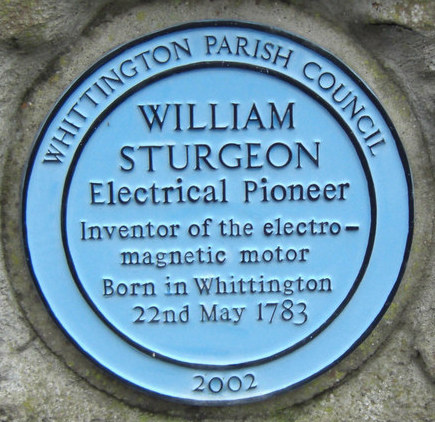 Lords
Saints
Places
People
Contact
Lords
Saints
Places
People
Contact
William Sturgeon
"Experiments are intended to teach, and not to mystify"
Inventor of the Electromagnet and the Electric Motor
William was born in Whittington, Kirby Lonsdale (1783), son of a shoemaker and poacher, and became a shoemaker himself (though helped his father with his sideline). He joined the Westmoreland Militia in 1802, volunteering into the 2nd Battalion Royal Artillery, 2 years later. During the next 16 years in the RA, some of which were spent deployed to Newfoundland, during his free time he taught himself maths, Latin, greek and natural philosophy. He left the artillery in 1820, briefly returning to shoe making in Lancaster, but soon relocated to Woolwich and began experimenting with electricity. By 1824 he became a lecturer, and exhibited the first practical electromagnet in 1825. For this, in 1825, William was awarded the silver medal of the Society for Promoting Arts and Commerce (now the Royal Society of Arts).
He went on to exhibit the DC electric motor with commutator (cylindrical set of contacts) in 1832, and in 1836 he invented the Galvanometer (measures small currents), and went on to improve the Induction coil, invented by Charles Page in 1836.
He was a founding member of the London Electrical Society in 1837, but unfortunately he fell out with his colleague Michael Farraday. After having an article on his electric motor declined for publication, he set up his own publication and criticised Farraday in an open letter in issue 1 :
"The errors you have fallen into in your Voltaic experiments are too palpable to escape notice, even of the humblest enquirer"
He criticised several other scientists, but was invited to be Superintendent of the Royal Victoria Gallery of Practical Science, founded in Manchester in 1840, and became good friends with James Joule. Unfortunately his Manchester ventures failed and he was left in poverty, with his lectures left as his only source of income. He would carry his apparatus around the villages of Manchester in a hand cart.
In 1847 Sturgeon suffered a severe attack of bronchitis, forcing him to move from Hulme to the cleaner air of Prestwich (13 Wash Lane) (Ref) which is now Clifton Road.
Number 13, was also known as Barnfield Terrace, this terrace was unfortunately demolished and is now a car park, behind the NatWest Bank today.
William was granted a civil pension of £50 in 1849 (worth about £6,300 today) which allowed him to publish a collection of his papers in Bury in 1850. It looks like he had made friends with Faraday as he was listed as a subscriber to the collection.
With his collection published, and friendship rebuilt, William died in Prestwich on 4th December 1850. He is buried in the churchyard of St Mary's, his funeral attended by several of his esteemed colleagues such as James Joule, his stone paid for by Edward William Binney, and he is identified on his grave slab in clear understatement as "William Sturgeon – The Electrician".
The names of scientists such as Watt, Farraday, Joule and Babbage are now part of the curriculum and general knowledge, twice-married Sturgeon however died a pauper is unmentioned. His good friend James Joule attended his funeral wrote a 30 page biography about him and his work.
A further memorial is displayed in Kirkby Lonsdale Parish Church (and another was on display in a local pub - The Green Dragon Inn, now the Snooty Fox) as he spent some time lecturing in the assembly hall that stood to the rear of the Inn, while staying there recovering from bronchitis.
Despite being shunned by the elite scientists of the day, and failing to turn his inventions into an income (it would surely have beee considerable), his inventions live on inside speakers, washing machines, motor cars, hair dryers, computer hard disk drives and MRI scanners to name just a few....
The memorial reads:
In Memory of William Sturgeon, Wm was born at Whittington A.D.1783 and buried at Prestwich Lancashire on the 4th day of December 1850. He was the son of parents in humble life and served as a private in the Royal Artillery for nearly 20 years. After completing his term of service he successfully devoted himself to the study of the physical sciences. With powers of originality and industry rarely equalled. Beside contributing numerous works to the scientific literature of his country, he was the discoverer of
The soft iron electro magnet
the amalgamated zinc battery
the electro magnetic coil machine and
the reciprocating magnetic electrical machine
Inventions of the finest value and which along with many others he freely gave to the world.
His name will be perpetuated as long as the science he cherished continues to exist.
Other links:
Paper by Dr Dew-Hughes
Encyclopedia Britannica
Thoughtco.com

Whittington Village (including images of his award and a letter to his second wife)
Wiki Quote
Made up in Britain
MEN Article
Intriguing History
Graces Guide
Nature Magazine Centenary
Computer Hope
Sturgeon and his Galvonometer
Faraday & Sturgeon